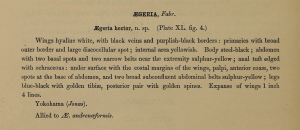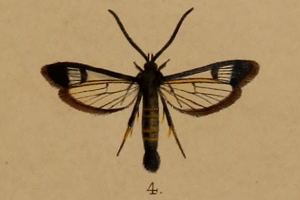

 +4Kontinente:EUAS
+4Kontinente:EUAS3. Biologie
3.1. Nahrung der Raupe
- [Rosaceae:] Prunus persica (Pfirsich)
- [Rosaceae:] Prunus armeniaca (Aprikose)
- [Rosaceae:] Prunus mume (Ume)
- [Rosaceae:] Prunus salicina (Chinesische Pflaume)
- [Rosaceae:] Prunus x yedoensis (Yoshino-Kirschbaum)
- [Rosaceae:] Prunus sp.
- [Rosaceae:] Malus pumila (Zwerg-Apfel)
- [Rosaceae:] Pyrus ussuriensis [= Pyrus simonii] (Ussuri-Birne)
- [Rosaceae:] Pseudocydonia sinensis sinensis [= Chaenomeles sinensis] (Chinesische Quitte)
- [Ebenaceae:] Diospyros kaki ?? (Kaki ??)
- [Sapindaceae:] Acer palmatum ?? (Fächer-Ahorn ??)
Arita (1994: 75-77) trägt zusammen: "HOSTPLANTS: Trunks of various species of Prunus, cultivated and wild cherry trees (Prunus x vedoensis, Prunus jamasakura), peaches (Prunus persica), Japanese apricots (Prunus mume), plums (Prunus salicina), apricots (P. armeniaca var. ansu), Ussurian pear (Pyrus simonii), apples (Malus pumila), Chinese quince (Chaenomeles sinensis) (all Rosaceae), maple (Acer palmatum, Aceraceae), cultivated persimmon (Diospyros kaki, Ebenaceae). The last three tree species were only once recorded as food plants."
Die Raupe gilt als Schädling an Malus pumila, Prunus persica, Prunus armeniaca und vielen anderen Prunus-Arten. Sie wird aber auch von Chaenomeles sinensis und einigen anderen Rosaceae genannt. Wie gut begründet Angaben zu anderen Pflanzenfamilien (Ebenaceae, Aceraceae, Symplocaceae, Sterculiaceae) sind, ist mir nicht klar.
Jin et al. (2008: 511) nennen aus China nur Malus pumila als Raupennahrung. Lee & Chung (2011) bezeichnen die Art als "major pest" an "Japanese apricot, Prunus mume" in Süd-Korea.
(Autor: Erwin Rennwald)
4. Weitere Informationen
4.1. Andere Kombinationen
- Aegeria hector Butler, 1878 [Originalkombination]
- Conopia hector (Butler, 1878)
4.2. Faunistik
Locus typicus ist Yokohama in Japan. Arita (1994: 75-77) schreibt zur Verbreitung: "Japan (Hokkaido, Honshu, Shikoku and Kyushu), Korea and Manchuria." Jin et al. (2008: 511) nennen Japan, China und Korea als Verbreitungsgebiet.
Kuchlein & de Vos (1999: 83) melden aus den Niederlanden: "In 1987 and 1988 two specimens of Synanthedon hector (Butler, 1878) were discovered in Prunus by the Plant Protection Service in Wageningen. The plants originated from Japan (G. Romeijn, i.l.)." Die Art ist in Europa (bisher) sicher nicht etabliert.
(Autor: Erwin Rennwald)
4.3. Literatur
- Arita, Y. (1994): The Clearwing Moths of Japan (Lepidoptera: Sesiidae). — Holarctic Lepidoptera, 1: 69-81. [PDF auf troplep.org]
- Erstbeschreibung: Butler, A. G. (1878): Illustrations of typical specimens of Lepidoptera Heterocera in the collection of the British Museum, 2: 1-62, pl. 21-40. [Digitalisat auf archive.org]
- Jin, Q., Wang, S.X. & H.H. Li (2008): Catalogue of the family Sesiidae in China (Lepidoptera: Sesiidae). — SHILAP Revista de Lepidopterología, 36 (144): 507-526. [PDF auf redalyc.org]
- Kuchlein, J.H. & R. de Vos (1999): Geannoteerde Naamlijst van de Nederlandse Vlinders - Annotated Checklist of the Dutch Lepidoptera. — 302 S.; Leiden (Backhuys Publishers)
- Lee, H.-S. & B.-K. Chung (2011): Occurrences of major pests in Japanese apricot, Prunus mume Siebold & Zucc. in Gyeongnam Province. — Korean Journal of Applied Entomology, 50 (1): 21-27. [Sekundärzitat nach dem Abstract auf [CABI.org]]









